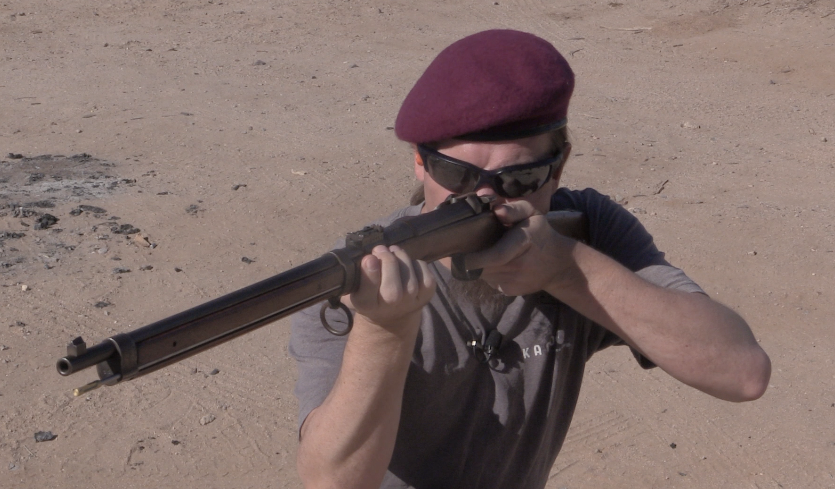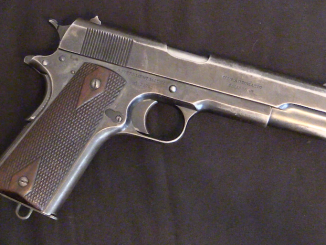The 1907 St Etienne heavy machine gun is a really neat gun mechanically, but I can’t shot you that today because this one is jammed together from the 7 bullet impacts that rendered it unusable a hundred years ago…
Related Articles

Uncategorized
Forgotten History: Vercors – the Climactic Battle of the French Resistance
The imposing heights of the Vercors Massif form a very impressive natural defensive position in the southeastern corner of France. It was here that the French Resistance had its largest set piece battle against German […]

Bolt Action Rifles
Uruguay’s Forgotten Mauser: the Dovitiis
Uruguay’s Model 1871/94 Mauser conversions – known usually as either Daudetau or Dovitiis Mausers – are a really interesting story of arms history. It begins with Antonio Dovitiis, and Italian tailor and merchant of military […]

Semiauto pistol
WW1 French Contract Colt 1911 for Tank Crewmen
France was in an interesting position during World War One of being a primary supplier of rifles and machine guns to its allies, but a major importer of handguns. In addition to a great many […]

Well, it’s hard to imagine how it could get much more “deactivated” than it is.
The blast shield attached to the barrel indicates that it was originally a fortress gun. That curved shield was intended to prevent muzzle blast reflecting back off the undersurface of a concrete firing port into the crew’s faces. It also tended to make “sniping” the crew through the firing port more difficult.
The St. Etienne ’07 was a classic example of the lengths governments will go to to avoid paying patent royalties. It’s fundamentally a Hotchkiss except for a rack-and-pinion system and a forward-moving gas piston.
The Hotchkiss gas piston is kicked backward to unlock the bolt. The ’07 has the piston reversed, going forward, and uses the rack and pinion to reverse the piston’s motion to operate the bolt.
It ended up as a “fortress” gun because it was such a PITA to keep running, and didn’t react well to “environmental factors” in he field. Both because the rack and pinion needed careful and frequent lubrication. But by 1915, the French army was so short of HMGs in the trenches that even the cranky ’07s were forward deployed. The poilus were probably not reassured by their presence.
The damage on the right side only indicates that either the MG post got flanked, or else while the gun was swung hard over to the left to engage a target on that flank, a German MG team in their front let them have it “head on”.
The missing rear sight and pistol grip probably indicates that after the gun was trashed, it was stripped of usable bits to repair other guns. So most likely the attack it was 86’d in didn’t succeed.
Maybe.
cheers
eon
Well, good example of rule that in peace time you can afford to posses wonky weapon (alternative: reject good enough weapon/system because NOT INVENTED HERE), but in war, when you need weapon that work you don’t bother whatever it is YOUR FAVORITE weapon (alternative: invented in your country) or not.
“rack-and-pinion system and a forward-moving gas piston”
See 4th photo from top here: http://world.guns.ru/machine/fr/stetienne-m1907-e.html
Apparently whoever actually designed the gun trusted in MORE GEARWHEELS BETTER or maybe just want to make steam-punk movie prop?
Landships: http://www.landships.info/landships/weapon_articles.html?load=weapon_articles/St_Etienne_Mle_1907.html
States that: Theoretically it was capable of firing 500 rounds per minute (which was adjustable by the gas cylinder between 8 to 650 rounds per minute) although far fewer in practice.
When I know that rate-of-fire regulator might be found on various early machine gun, the 8 rounds per minute looks ridiculously low (one shot each 7.5 second)
Given all that “fortress gun” apparatus, it seems odd to me that it has all those hits to the side of the receiver, which I would have assumed to be pretty securely far back in the bunker. Might there have been other firing ports in such a bunker, through which the disabling rounds might have entered?
I’m assuming the gun was forward deployed in a machine gun nest, in the trench lines, as opposed to a fortress embrasure.
BTW, declaring a gun “suitable for fortress duty” was one of the French Army’s two stock methods for ridding themselves of poorly-designed and/or built weapons and equipment, without admitting they’d screwed up ordering same into service to begin with.
The other was declaring the wretched beast “suitable for tropical use”.
After which said POS would be shipped off to a fortress well in the rear areas, or to an overseas colony, and foisted on garrison troops who generally hoped like hell they’d never need to actually use the bloody thing.
Troops along the Spanish border and the Legion Etrangere’ were the most frequent victims.
cheers
eon
Hello from Athens , Grecce
“hard to imagine how it could get much more “deactivated” than it is.”?????????????????
Well , eon , i think you should a look at the English law .
I am sure you will get some more excellent perverted ideas on the subject .
Have a nice week .
M.
One time at the National Museum of the United States Air Force at Fairborn, OH, I ran across a dozen Pontiac-built M39 revolver-breech 20mm cannon lying in a stack, in the grass behind a hangar.
A very nice Air Policeman, who naturally wanted to know what I was doing there, was as surprised as I was to see them. They’d apparently been pulled from a trio of F-100 Super Sabres that were being converted to drones, and just deposited there for the usual no very good reason.
It occurred to me that a working M39 in decent shape would be quite something to bring to a machine-gun shoot.
Loaded with inert practice ammunition, naturally.
😉
cheers
eon
There is an almost identical armor arrangement on a machine gun at the Musée de l’Armée (in the Hôtel des Invalides in Paris)
The gun in the museum is perhaps a variant of the St Etienne (I’m not sufficiently versed to say for sure.)
I was there this past December.
Photos at https://flic.kr/p/DYQNuC and https://flic.kr/p/DAMCfV
Well Matisse, this is in fact the 1914 Hotchkiss, just with the identical blast shield at the muzzle.
BTW, it seems to me that the St Etienne at RIA has only three bullet impacts (these neat, round holes in the receiver), while the rest seems like shrapnel damage (ragged irregular holes). Wouldn’t like to catch any of these, but still – bullets they are not.
I agree 100%.
If you look closely at the foremost hole, it is distinctly rounded. The ragged edges on some of the holes may simply be due to the different material in the fore end as opposed to the receiver. If it is harder or otherwise more brittle then it may tend to chip instead of simply resulting in a neat hole. The side of the receiver and the cover on the top may be made from rolled steel plate or steel bar, while the fore end looks like a casting of some sort.
I think you’re quite correct, MG, at least as far as my own experiences and observations are concerned. Also, the less concentric strikes may have resulted from the St. Etienne being hit at a different angle as the enemy weapon(s) that did the damage shifted position relative to the St. Etienne, which would support the idea that the latter ( and possibly its unfortunate crew ) was the victim of a flanking attack using a portable MG such as a Bergmann MG15nA, air-cooled light-barreled Parabellum MG or even an MG08/15, all of which, equipped with bipods, saw some service as “light” machine guns. In fact, the Bergmann and light-barreled Parabellum weighed little more than modern-day GPMG’s and would have been quite suited to mobile warfare. The other possibilities are that the enemy troops were using captured Lewis guns or Chauchat or BAR machine rifles, or may have delivered simultaneous fire from several infantry rifles from the flank.
Thanks Leszek, I’ve update the comments on my photos on flickr.
Too bad it can’t be documented to Fort Douaumont or the other Verdun forts.
Hmm… Bureaucrats often seem to supply the most poorly advised stuff to the troops just for reasons of cheapness, office politics, or “nationalistic pride.” Personally, if I were a logistics commander and I wanted the good weapons, I would stop listening to political cronies and start looking for things on the private sector. Maxim guns, like the Gatling guns, the Nordenfelts, and the Gardeners before them, were first sold privately to military units who had enough cash to spare. The commanding officers of said units often had to improvise new strategies in order not to be overrun due to mechanical problems.
First issue: machineguns are seldom good artillery substitutes (what idiot treats a Gatling like a 12-pounder!?). Rifle caliber rounds used for indirect fire generally won’t hit anything important unless one is hoping to hit his enemy in his sleep. And even then, good luck getting away from artillery counter-barrages ordered in retaliation!
Second issue: static defensive machineguns should never be deployed in singletons. What I mean is that should the heavy firepower be only one machinegun faced off against a charging line of 200 infantrymen spaced two meters apart from each other, the machinegun will not be able to fend off the entire attack before requiring a reloading cycle. A pair of heavy machineguns, or better yet, a quartet in good positioning, would do the job much better. Each machinegun should be positioned so that it can cover for one or more of its companions if needed and therefore create a no-charge-zone.
Third issue: logistics of ammunition and weapons training for any particular machinegun. Assuming the design is actually going to work in battle (I pity those who had to use the St Etienne), the operators had better remember when it’s time to reload and when maintenance begins. Otherwise, the gun’s going to be useless when it breaks.
Did I mess up anything?
Weapon of choice scenario:
Okay, fortress defense isn’t my forte, but I’ll try to get this to work. Assuming that we are manning heavily fortified positions with virtually no mud in the works, which gun will you man if the fort is under heavy siege? I’m really sorry to say that most of the better guns are in need of spare parts, and the next shipment of goods isn’t coming until the road is clear…
1. 1907 St. Etienne
2. Furrer M25
3. Reibel twin mount
4. Fiat-Revelli 1914
5. SIG KE-7 (obviously not a static piece)
6. Mauser T-gewehr and/or 37mm McClean automatic cannon
7. QF 6-pounder Hotchkiss
8. ROKS-2 flamethrower
9. Get something else!!
This activity is completely voluntary. You are not required to participate if you do not wish to do so. Please keep any and all criticism of this post humane and free of foul language.
Thank you,
Cherndog
If range isn’t an issue, I’ll take the flamethrower and a couple of crates of anti-personnel mines.
Otherwise, I’d prefer the 6-pounder. Machine guns, good or bad, aren’t much use if some Mother’s Son on the other side shows up in an armored car or early tank.
cheers
eon
“9. Get something else!!”
As mass is not issue there get 2cm Tankabwehrkanone Becker M11
http://landships.info/landships/artillery_articles.html?load=/landships/artillery_articles/TAK_Becker.html
The two holes farthest back on the receiver are so precisely at 90º, leaving such perfect perforations, that I wonder if they weren’t put into the gun with slow deliberation.
Perhaps the strongpoint had fallen to the Germans and they were later forced to pull back? Tell Hans and Fritz to put a couple of rounds into the mechanism and get out of Dodge.
See also, about the muzzle device in use: https://www.forgottenweapons.com/hotchkiss-1914-cow-catcher-muzzle-device/